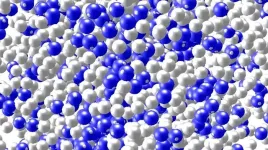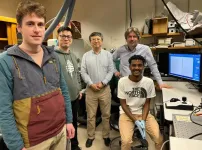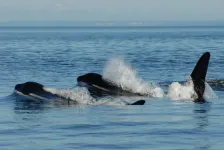(Press-News.org) NEWPORT, Ore. – Marine heat waves in the northeast Pacific Ocean create ongoing and complex disruptions of the ocean food web that may benefit some species but threaten the future of many others, a new study has shown.
The study, just published in the journal Nature Communications, is the first of its kind to examine the impacts of marine heat waves on the entire ocean ecosystem in the northern California Current, the span of waters along the West Coast from Washington to Northern California.
The researchers found that the biggest beneficiary of marine heat waves is gelatinous zooplankton – predominantly cylindrical-shaped pyrosomes that explode in numbers following a marine heat wave and shift how energy moves throughout the food web, said lead author Dylan Gomes, who worked on the study as a postdoctoral scholar with Oregon State University’s Marine Mammal Institute.
“If you look at single species interactions, you’re likely to miss a lot,” Gomes said. “The natural effects of a disturbance are not necessarily going to be straightforward and linear. What this showed us is that these heat waves impact every predator and prey in the ecosystem through direct and indirect pathways.”
The project was a collaboration by Oregon State University and the National Oceanic and Atmospheric Administration. Joshua Stewart, an assistant professor with the Marine Mammal Institute, mentored Gomes and co-authored the paper.
“What I found both alarming and fascinating is the extent to which these pyrosomes absorb all of the energy in the system,” Stewart said. “Because nothing else really eats the pyrosomes, they just become this dead end, and that energy is not available for anyone else in the ecosystem.”
Marine heat waves are periods of prolonged, unusually warm ocean temperatures. The prevalence and intensity of marine heat waves is increasing around the globe. While the impacts of these heat waves on marine species have been well-documented on individual and population levels, the effects on the entire ecosystem have not been well understood, Gomes said.
To gain a more holistic view of the impact of marine heat waves, Gomes updated an end-to-end ecosystem model with new data on marine life throughout the ocean food web that was collected during local biological surveys.
He then compared how the food web worked before and after a recent spate of marine heat waves, including a large, well-documented event in 2013-2014 known as “the blob.” Much of the new data used in the model was collected following that event as researchers tried to better understand its impacts.
Some of the impacts were predictive – pyrosomes, for example, are known to thrive in warmer waters – but the analysis also showed that the ecosystem functions in ways that are not intuitive, Gomes said.
For example, the modeling showed how the dominance of pyrosomes drew energy out of the food web. That loss of energy is most likely to affect fish and marine mammals that are higher up the food chain, potentially impacting economically important fisheries and recovery efforts for threatened or endangered species, Stewart said.
Huge influxes of pyrosomes in the waters and on beaches in the Pacific Northwest in 2017 and 18 drew widespread public attention. Data from those events was included in the updated model.
The updated model used in the study could help commercial fisheries adapt harvest strategies that are impacted when fish commonly found in one area move to escape the encroaching warm water or their populations drop due to lack of available food following a marine heatwave.
Numbers of Pacific jack mackerel, for example, have increased following marine heat waves, but so far, fisheries have not shifted to catching them, the researchers noted.
The researchers’ methods could also provide a template for future research to understand the impact of these events elsewhere, Gomes said.
Additional coauthors of the paper are James Ruzicka of NOAA’s Pacific Islands Fisheries Science Center and Lisa Crozier, David Huff and Richard Brodeur of NOAA’s Northwest Fisheries Science Center. Gomes is now with U.S. Geological Survey.
The Marine Mammal Institute is part of Oregon State’s College of Agricultural Sciences and is based at Hatfield Marine Science Center in Newport. NOAA’s Northwest Fisheries Science Center also has a research station at Hatfield.
END
Marine heat waves disrupt the ocean food web in the northeast Pacific Ocean
2024-03-13
ELSE PRESS RELEASES FROM THIS DATE:
The 11th World Congress on Microbiota Medicine critically evaluates probiotic supplementation strategies
2024-03-13
The International Society of Microbiota (ISM) announces its 11th World Congress, "Targeting Microbiota 2024", scheduled for October 14-15 at the Corinthia Palace in Malta. This event is set to highlight the latest research and developments in microbiotal medicine, emphasizing its impact on human health and its potential in shaping future medical treatment approaches.
Detailed Workshop: Probiotic Prescribing Practices dedicated to Medical Professionals
The congress will feature a critical workshop on October 15, titled “Probiotic Prescribing Practices: Empowering Medical Doctors for Improved Patient Health.” ...
Engineering Biology Research Consortium releases roadmap to mitigate, present and adapt to climate change
2024-03-13
Engineering Biology for Climate & Sustainability is the fifth technical roadmap developed by the Engineering Biology Research Consortium (EBRC) and represents the first dedicated to innovations and opportunities towards overcoming a significant global challenge. The roadmap targets and challenges are aligned and were drawn from existing climate and sustainability literature, particularly those focused on long-term impacts and opportunities, including reports from the United Nations’ Intergovernmental Panel on Climate Change and the U.S. Environmental Protection Agency.
The roadmap consists of six themes ...
Strengthening the partnership between humans and AI: the case of translators
2024-03-13
ChatGPT and its ability to hold conversations and produce written content have been the focus of a lot of attention in the last year in the field of technology and artificial intelligence. However, AI has been around for some time, helping us in all sorts of everyday tasks, from navigation systems to social network algorithms, not to mention machine translation. Ever since neural machine translation (NMT) systems began to be used on a widespread basis a few years ago, AI has seen exponential growth in its uptake in the translation industry. This has led to new challenges in the relationship between human and machine translators.
Today, the post-editing ...
Milk to the rescue for diabetics? Cow produces human insulin in milk
2024-03-13
An unassuming brown bovine from the south of Brazil has made history as the first transgenic cow capable of producing human insulin in her milk. The advancement, led by researchers from the University of Illinois Urbana-Champaign and the Universidade de São Paulo, could herald a new era in insulin production, one day eliminating drug scarcity and high costs for people living with diabetes.
“Mother Nature designed the mammary gland as a factory to make protein really, really efficiently. We can take advantage ...
Molecular simulations of ammonia mixtures support search for renewable fuels
2024-03-13
Ammonia (NH3) is an important molecule with many applications. The end product of the famed Haber–Bosch process, it is commonly synthesized to capture nitrogen for fertilizers, and is used for refrigeration, in cleaning products, and in the production of pharmaceuticals. Recently, this modest molecule has also attracted interest as a potential resource for addressing one of today’s most pressing challenges — the need for reliable and abundant renewable fuels.
Ammonia is stable and safe ...
First recognition of self in the mirror is spurred by touch
2024-03-13
Most babies begin recognizing themselves in mirrors when they are about a year and half old. This kind of self-recognition is an important developmental milestone, and now scientists at The University of Texas at Austin have discovered a key driver for it: experiences of touch.
Their new study found babies who were prompted to touch their own faces developed self-recognition earlier than those who did not. The research was published this month in the journal Current Biology.
“This suggests that babies pulling ...
Dartmouth engineering team discovers new high-performance solar cell material
2024-03-13
A Dartmouth Engineering-led study published in Joule reported the discovery of an entirely new high-performance material for solar absorbers—the central part of a solar cell that turns light into electricity—that is stable and earth-abundant. The researchers used a unique high-throughput computational screening method to accelerate the discovery process and were able to quickly evaluate approximately 40,000 known candidate materials.
"This is the first example in the field of photovoltaics where a new material has been found through this type ...
Advancing toward wearable stretchable electronics
2024-03-13
Small wearable or implantable electronics could help monitor our health, diagnose diseases, and provide opportunities for improved, autonomous treatments. But to do this without aggravating or damaging the cells around them, these electronics will need to not only bend and stretch with our tissues as they move, but also be soft enough that they will not scratch and damage tissues.
Researchers at Stanford have been working on skin-like, stretchable electronic devices for over a decade. In a paper published ...
Menopause explains why some female whales live so long
2024-03-13
Females of some whale species have evolved to live drastically longer lives so they can care for their families, new research shows.
The study focussed on five whale species that – along with humans – are the only mammals known to go through menopause.
The findings show that females of these whale species that experience menopause live around 40 years longer than other female whales of a similar size.
By living longer without extending their “reproductive lifespan” (the years in which they breed), these ...
Supply chain disruptions will further exacerbate economic losses from climate change
2024-03-13
UCL Press Release
Under embargo until Wednesday 13 March 2024, 16:00 UK time / 12:00 US Eastern time
Global GDP loss from climate change will increase exponentially the warmer the planet gets when its cascading impact on global supply chains is factored in, finds a new study led by UCL researchers.
The study, published in Nature, is the first to chart “indirect economic losses” from climate change on global supply chains that will affect regions that would have been less affected by projected warming temperatures.
These previously unquantified disruptions in supply chains will further exacerbate projected economic losses due ...





